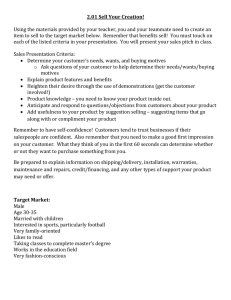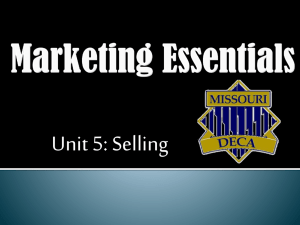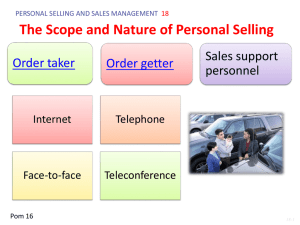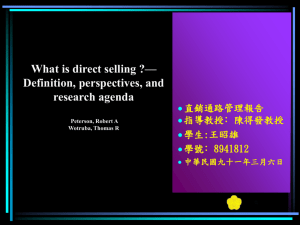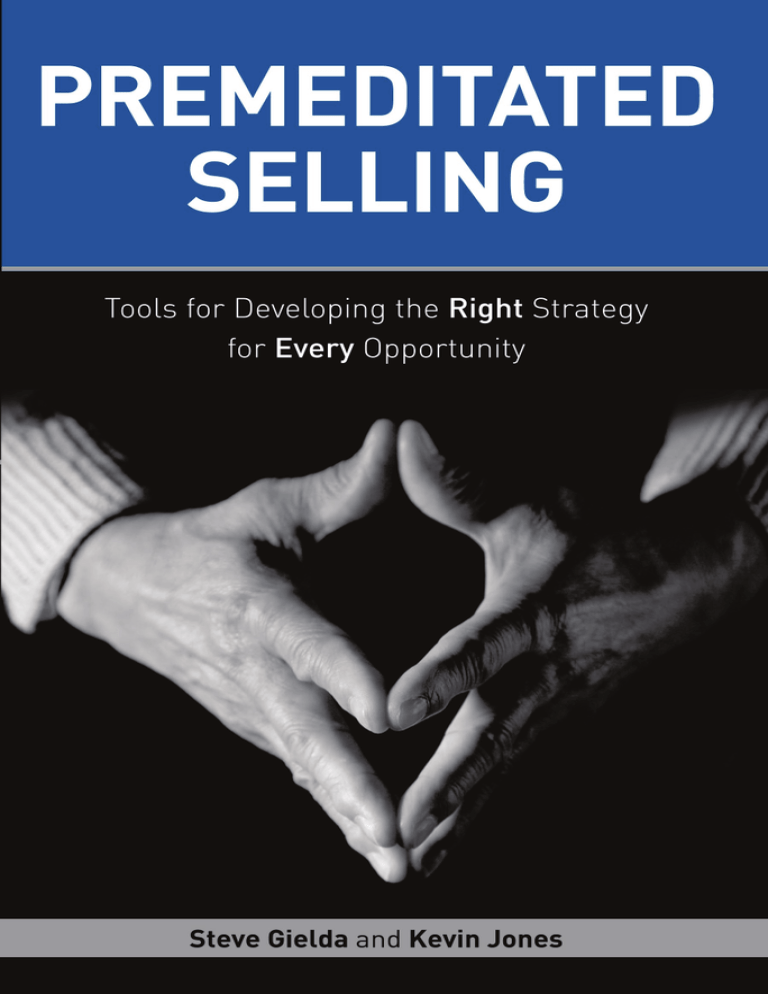
Premeditated
Selling
Tools for Developing the Right Strategy
for Every Opportunity
Steve Gielda and Kevin Jones
© 2012 the American Society for Training & Development
All rights reserved. Printed in the United States of America.
No part of this publication may be reproduced, distributed, or transmitted in
any form or by any means, including photocopying, recording, or other
electronic or mechanical methods, without the prior written permission of the
publisher, except in the case of brief quotations embodied in critical reviews
and certain other noncommercial uses permitted by copyright law. For
permission requests, please go to www.copyright.com, or contact Copyright
Clearance Center (CCC), 222 Rosewood Drive, Danvers, MA 01923
(telephone: 978.750.8400, fax: 978.646.8600).
ASTD Press is an internationally renowned source of insightful and practical
information on workplace learning and performance topics, including training
basics, evaluation and return-on-investment, instructional systems
development, e-learning, leadership, and career development.
Ordering information for print edition: Books published by ASTD Press can
be purchased by visiting ASTD’s website at store.astd.org or by calling
800.628.2783 or 703.683.8100.
Library of Congress Control Number (print edition only): 2012940628
Print Edition ISBN: 978-1-56286-844-4
PDF eBook Edition ISBN: 978-1-60728-741-4
ASTD Press Editorial Staff:
Director: Glenn Saltzman
Community of Practice Manager, Sales Enablement: Mike Galvin
Associate Editor: Stephanie Castellano
Design and Production: Lon Levy
Cover Design: Ana Foreman
Contents
Preface...........................................................................................................v
Acknowledgments......................................................................................ix
Chapter 1: Thinking and Acting Strategically.........................................1
Chapter 2: Understanding Buying Factors............................................13
Chapter 3: Managing Key Players...........................................................29
Chapter 4: Knowing Your Environment................................................53
Chapter 5: Influencing the Competitive Landscape.............................71
Chapter 6: Quantifying Value..................................................................95
Chapter 7: Pipeline Management........................................................ 117
Chapter 8: Developing a Sales Coaching Strategy ............................ 137
About the Authors.................................................................................. 167
About Ignite Selling, Inc........................................................................ 169
Preface
We have been working with sales leaders in Fortune 1000 companies
for more than 15 years. During that time alone there have been many
books written on strategic account management and many training
programs developed with the intent of helping salespeople become
more effective when working with their top accounts. A few years ago,
we were working with the vice president of sales at a large Fortune 1000
company. This person told us that he needed a way to help make the
company’s strategic account management process more actionable. He
wanted a way to help his team think and act strategically. He wanted
his team to be more proactive in analyzing the multiple opportunities
within a single account and be smarter in the way they put together a
strategy to win the business. This VP needed his team to be able to use
the strategic account management process in a way that would help
them determine where they should invest time, who they should invest
time with, and which strategy would best demonstrate the company’s
ability to help their customers achieve their business outcomes.
We assumed that since this company had already implemented a reputable strategic account management process, they had every tool they
needed to be successful. Unfortunately, we were wrong. Instead the
v
Preface
“process” being implemented inside this company was seen by the
sales force as nothing more than forms, unnecessary paperwork. And
while these forms were excellent repositories of information, they did
little to change the way the salespeople approached their business.
The sad reality is that this company, and its VP of sales, aren’t alone.
In fact, there are many companies, of all shapes and sizes, implementing strategic account management processes without achieving the
intended results. Our experiences with many other Fortune 1000 companies have revealed that many salespeople are not using their strategic
account management process to think and act more strategically when
working with their top accounts. Instead, they are merely filling out
forms believing they are being strategic in their approach, and unfortunately, their sales managers are encouraging that behavior.
Our experiences with top-performing salespeople show that they know
how to think and act strategically. Top performers are more intentional
in their strategic account planning and meditate on their approach before acting. Top performers don’t just collect data and fill out forms,
they know what data to collect and what actions need to be taken to
successfully leverage that data. This book has been written to help you
become more actionable, intentional—more “premeditated”—in the
way you approach every sales opportunity.
vi
Premeditated Selling
This book provides you with a set of tools to help you organize critical
opportunity data and ideas for how to use that data in developing an
opportunity strategy. We broke this book into five segments that are
fundamental to any sales strategy. Within these segments we identify
the types of information any seller needs, provide tools to organize the
information, and ideas to analyze the information and develop a path
forward. Each of the segments, although independent of each other,
work together to provide a complete plan for a sales opportunity. These
tools work. We’ve used them and our customers have used them. Approaching any sales opportunity without them is like taking a long
drive without a map.
While this book is intended for salespeople and sales leaders, those
individuals aren’t the only ones who can benefit from the application
of the concepts. Knowing how to develop the right strategy for every
opportunity isn’t going to just help a salesperson win more deals, it is
going to help the business manage critical functions that rely so heavily
on accurate sales forecasting. Operations will have a better sense for
planning, finance will have a better handle on future cash flow. Deals
that inexplicably move from “won” to “lost” don’t just impact the salesperson’s commission—they impact the way businesses run.
“There are plenty of books on sales strategy but very few that are as useful as this
one. I greatly respect Steve and Kevin’s contribution.”
Neil Rackham
Executive Professor of Professional Selling
University of Cincinnati
Author of the classic SPIN Selling
vii
Chapter 1
Thinking and
Acting Strategically
A darkened plane at 35,000 feet—a late-night flight home from a tough
client meeting—is a great place to reflect. And on this flight, there is a
lot to reflect on. A deal had been lost. This opportunity had seemed a
sure thing, a sure thing that was now dead. Why? A mental post-mortem
of any sales opportunity is—or ought to be—inevitable, especially for
an opportunity that slid inexplicably from the “won” to the “lost” column. Questions of what could have been will haunt your thoughts.
What was missed? Was the pricing model off? Did a key influencer
get overlooked? Was my competitor’s solution really better than mine?
Ultimately, salespeople on the losing side are desperate to know why
their opportunity went south.
1
Chapter 1
And You Think You Lost Because of Price?
Although much has changed in the field of sales during the two decades
we’ve been in this business, one element that hasn’t changed is a salesperson’s readiness to blame a lost opportunity on price. In our years as
sales performance consultants, we have asked salespeople the following question countless times: “Why do you think the customer selected
your competitor?” By far, the number one response to this question is
“price.” It may be phrased in a number of ways, but the crux of the message is, “I couldn’t create enough value for my customer to select my
solution over other less costly alternatives.” Ironically, although price
is the reason sellers most commonly give for losing a deal, it is seldom
the reason customers give for choosing the competition.
Just recently, we were working with the sales team of a large software
company. Part of our project was to evaluate lost opportunities in
hopes of finding out what was going wrong. Salespeople inside this
organization clearly felt that the majority of deals lost were due to noncompetitive pricing. In fact, in the evaluation of these lost opportunities, salespeople blamed price for the loss in more than 75 percent of
the cases. In post-mortem interviews with clients, however, we heard
a different story. Not only was price not the number one reason customers chose an alternative solution; price didn’t even make their top
three. Instead, customers provided other reasons for selecting alternative solutions, such as not being comfortable with the company’s level
2
Thinking and Acting Strategically
of post-sales support, the lack of efficacy data for the product, the ease
of use or training curve of implementing the new product, and so forth.
The fact that price was rarely mentioned as a deciding factor came as
a surprise to the salespeople who had worked with these customers.
How could they have overlooked the real reasons their customers went
with the competition?
The sad truth for our client—and for many sellers on the losing side—
is that there was little understanding of the buying process the client
was going to use, who was going to be involved in the process, and
which factors were going to be important when evaluating alternatives.
What do you do in the absence of good information? You make assumptions about what’s important and why. Sellers will approach clients by emphasizing product strengths and attributes that they believe
are important. They will anticipate issues and challenges that have presented themselves before. Sometimes a salesperson will get lucky in
this method and hit his mark, but more often, he will not. Acting on
assumptions, letting history solely influence your approach—in short,
depending on luck, makes for a pretty poor sales strategy.
Getting Ahead of the Curve
With enough analysis, and the right customer resource, any salesperson can uncover the real reason an opportunity went south. Unfortunately, having this knowledge doesn’t change anything—the deal is
3
Chapter 1
done, and you came out on the losing end. But wouldn’t it be nice to
have known the reasons you lost before the deal was actually over? If
you had known you were in a losing position, what would you have
done differently? The process we provide in this book, when used appropriately, can minimize the need for lost opportunity post-mortems
by helping you win more and lose less. It will help you understand
where you stand in the eyes of the customer, by highlighting your
strengths and revealing your vulnerabilities. Gaining this insight allows you to act before it’s too late. And while the information you procure may prompt you to take a variety of actions, from modifying call
points, to bringing in additional resources, or simply walking away, it
is this ability to act on good information that will alter your outcomes.
One Word—Strategery
During the 2000 United States presidential election, Will Ferrell performed exceptional impersonations of George W. Bush on Saturday
Night Live. During one such performance, Ferrell’s character was asked
to sum up his presidential campaign in one word. Ferrell’s response
was as memorable as it was brief—“strategery.” As laughable as the
word is, it may just be the best summation of the process many salespeople employ when approaching major sales opportunities. Many
salespeople spend time gathering account information; they then put
that information into a company-mandated account strategy “form,”
and then they sit through an agonizing meeting that management
4
Thinking and Acting Strategically
often calls an “account planning session.” Unfortunately, these meetings are more like an interrogation of the sales rep so that the manager
can be brought up to speed on the account. There is very little value
created by this process—this is strategery.
What Does “Premeditated Selling” Mean?
We struggled in coming up with a title for this book that would reflect
the value of the solution we present inside its covers. We asked ourselves countless times, “What is it that we hope people will do differently after reading this book?” The answer is simple. We want people
to give more forethought to how they manage a sales opportunity. We
want them to develop more proactive strategies that will help create
opportunities for success. There were a lot of terms we could have used
in our title, but we settled on premeditated because of its direct meaning—“to meditate, consider, or plan beforehand.” Putting aside the
term’s association with well-planned crime, the definition was an exact
description of what top salespeople do when working on an important
sales opportunity—they meditate, consider, and plan beforehand.
A Premeditated Selling Process
This book will show you how to develop a sales plan for each unique
opportunity inside your accounts, using a five-step process that has
proven itself successful. This process evaluates a sales opportunity
5
Chapter 1
from various angles, providing you insight into your situation and
ideas for moving forward. Each step provides tools to help you analyze an opportunity and gather the information you need to make your
next move. The five steps of the Premeditated Selling Process are:
1. Understanding the buying factors
2. Leveraging the key players
3. Optimizing the buying environment
4. Influencing the competitive landscape
5. Quantifying the value of your solution
Step 1—Understanding the buying factors: the analysis of the buying process your customer will use for making their purchasing decision. By understanding how your customer will actually make their
decision, you can modify the speed with which you act, the resources
you use, and the strengths you present. We’ll explore this topic a bit
further in chapter 2. We’ll challenge you to think about the answers
to questions like:
• How has the buying process for similar products gone
in the past? Is it a consistent process?
• What is the sense of urgency driving your customer’s
buying process?
• Is there a need for consensus among the decision makers
or is diversity of opinion okay?
6
Thinking and Acting Strategically
In today’s market we must be able to answer these questions plus many
others regarding our customers’ buying factors.
Step 2—Leveraging the key players: the analysis of the individuals involved in the buying process—their influence and their perceptions of
potential solution providers. By gaining insight into your advocates and
adversaries, including who they support and why, you can develop a
plan of action to capitalize on your positive relationships while minimizing potential threats. In chapter 3, we’re going to take a deeper dive
and provide you with a tool that will help you better analyze the key influencers in every sales opportunity. We’ll challenge you to think about
the answers to questions like:
• What’s been said or done to make you believe your advocate
is really your advocate?
• Is there a way to leverage your advocates to neutralize your
adversaries? If so, how can that be done?
• Who are your competitors’ advocates? Are they the same
as yours?
We’ll help you better analyze all the key influencers involved in
your opportunity so you can develop a smart strategy to leverage
advocate support.
Step 3—Optimizing the buying environment: the analysis of the
trends in your customer’s industry and how they affect your customer,
7
Chapter 1
specifically the executives inside your customer’s organization. By
evaluating what’s happening in your customer’s world, you can anticipate unique challenges and prepare yourself to address needs that your
competitors may not have considered. In chapter 4, we’ll introduce you
to a model that will help you think about how a single trend in the
market impacts the customers in your territory; and more importantly,
how it changes the way your customer makes purchasing decisions.
We’re going to challenge you to think about:
• Which market trends are having the greatest impact on this
customer? How will they affect your sales efforts?
• What new initiatives has this account taken to leverage or combat
these new trends?
• What responsibility do these stakeholders have to help their
company take advantage of or combat the trends in the market?
This chapter contains two case studies that reveal best practices for
reacting to your customer’s buying environment, and show you how to
avoid the common traps salespeople often fall into in this part of the
sales planning process.
Step 4—Influencing the competitive landscape: the analysis of your
competitive position through an understanding of what selection criteria your customer will use and how they compare you to the competitive alternatives. By thinking broadly about the criteria a customer
8
Thinking and Acting Strategically
will use to make a decision and knowing your strengths and weaknesses against those criteria, you can develop a strategy to capitalize on
your strengths and minimize your weaknesses. In chapter 5, we’re going to challenge you to reassess your understanding of your customer’s
decision criteria. You’ll be prompted to consider questions such as:
• Who have you spoken with to confirm the customer’s
selection criteria?
• If there are multiple decision makers, do they all agree on
the same selection criteria? Whose selection criteria matters
most and why?
• How does the customer perceive your ability to meet their needs?
Step 5—Quantifying the value of your solution: the analysis of your
solution’s “value,” which enables you to position your solution effectively. By using the classic value equation, you can develop a strategy
to build economic value, either through actual or conceptual benefits.
In chapter 6, we’re going to stretch your thinking around how your
customer measures value. We’re going to push you to think about:
• What are the most important business outcomes your customer
will receive by implementing your solution?
• How will your customer measure your solution’s value?
• What metrics have you chosen to measure the value impact
of the outcomes?
9
Chapter 1
All too often salespeople underestimate the importance of quantifying the value of their solution. They assume the customer can make
the connection between their solution and the impact it can have on
the customer’s metrics. Unfortunately, these kinds of assumptions can
make the difference between winning or losing the opportunity.
Chapter 7 explores the importance of aligning your pipeline or funnel
management system to your Premeditated Selling Process. Too often
steps are skipped accidentally or maybe even on purpose. Establishing
strategic milestones along the way will help both you and your manager know what’s happening in the account and which critical next
steps need to be taken to move the sales process forward in your favor.
Chapter 8 is dedicated to sales managers. We know that managing a
sales team in today’s market isn’t easy. You are being pulled in many
different directions. You’re asked to help close this deal, help put out
this fire, and to be sure you have your weekly or monthly reports in
on time. The list of things you must do never seems to end. So how in
the world do you have time to help your team to think and act more
strategically with their top opportunities? In this chapter, we’re going
to provide you with a simple six-step strategic coaching process that
will help you guide your sales reps in developing initial strategic opportunity plans. We’ve included a list of strategic coaching questions
that every manager should be asking their sales reps. We hope this
10
Thinking and Acting Strategically
chapter provides you with the additional tools needed to help your
team win more deals.
Getting Started
Common sense should tell you that you need to develop a strategy
before you begin to implement it. If not, it would be like the proverbial “cart before the horse.” But developing a strategy sounds akin
to planning, which many people equate to paperwork, and we don’t
know many salespeople who even remotely like paperwork. Filling
out forms and reports can feel like a waste of time; and indeed, it does
keep sellers from really crucial sales activities, like actually talking to
customers. Is it any wonder so many salespeople shrink from formal
planning processes?
It is our intention to help you think differently about strategic opportunity planning. Ease of use and immediate relevancy should characterize all sales planning efforts. With this in mind, we have designed tools
to walk you through the five steps of the Premeditated Selling Process.
These tools provide a framework for consistency, so that sales planning
processes are repeatable and information can be shared across an enterprise in a commonly understood way. As you complete these tools,
they may reveal gaps in your knowledge about your accounts, which are
then up to you to fill. A well-designed tool can enable you to evaluate a
11
Chapter 1
situation and organize your information. But it’s what you do with the
information that matters.
The premeditated approach to selling that we present in this book won’t
win you every opportunity that comes your way. But it’ll help you win
more of them. And if you lose, you are equipped to uncover the real
reasons why—information that can empower you to win the next one
around—instead of defaulting to the infamous excuse of pricing.
12




